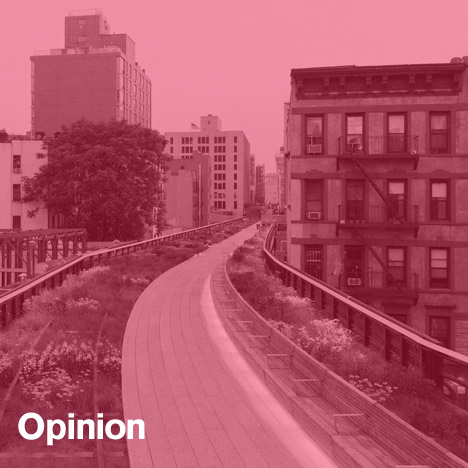
"Engagement with real, local conditions is crucial for architecture's global relevancy"
Opinion: city mayors are becoming increasingly powerful political figures in the architectural world, offering an opportunity for architects to act as local advocates and create a counterpoint to forces of globalisation, says Mimi Zeiger.
A few weeks ago at a conference in Mexico City, architect Elizabeth Diller took the stage of the Teatro Metropolitan and presented a series of projects culled from her firm's growing oeuvre on the theme of the city. She guided the audience gathered in the faded splendour of the vast auditorium through each work — the shrewd Lincoln Center, the precedent-setting The High Line, the upcoming Culture Shed, among others (notably minus the scheme for a supersized MoMA).
As she discussed Diller Scofidio + Renfro's interest in "the fate of the city," a throughline appeared: the studio's relationship with former New York City mayor Michael Bloomberg. Not only did his leadership coincided with some of the practice's most significant projects, Diller suggested that she is in conversation with the C40 Cities Climate Leadership Group (C40), an organisation composed of mayors from around the globe. Bloomberg chaired the group for three years and is now president of the board of directors.
While it is neither particularly novel nor damning for architects and mayors to fraternise, urban magistrates are appearing more frequently as personas on the architectural scene as designers tackle questions of the fate of the city. In fact, the Mextropoli architecture conference in Mexico included Barcelona's former mayor Jordi Hereu and Antanas Mockus, former mayor of Bogota, Colombia. And this week Storefront for Art and Architecture in New York opened the exhibition Letters to the Mayor. The show, which runs through May, presents some fifty letters from architects and critics to more that twenty city leaders from around the globe, including my own letter to Los Angeles mayor Eric Garcetti.
So, why all the interest in mayors? The emergence of the mayor as a political figure within contemporary architecture could represent a localised counterpoint to globalising forces, especially as it coincides with dust-ups over the place for politics within the discipline. Or, as in the case of Bloomberg and the C40, it may represent a well-meaning but insidious chumminess with those very forces.
The ambiguity illustrated by these two representations also points at a similarly equivocal attitude for architects: local or global, insider or outsider. Diller's own lecture was lightly peppered with agonistic vocabulary even as she outlined powerful allegiances. Politically poetic, she described the (now cancelled) Hirshhorn Museum bubble as inflated by "participatory democracy," aka the air drawn in from The Mall. Of the firm's Zaryadye Park in Moscow, she noted that the scheme's "wild urbanism" was a kind of resistance to the status quo, a troublingly pat aside given Russia's actions in the Ukraine.
In the vignette performed on the stage of the Teatro Metropolis, the architect is simultaneously mayoral consigliere and rabble-rouser. Both roles are glamorous, with a hefty dose of sexual tension between the two. (That powerful frisson was famously captured in a January 1975 photograph of New York City mayor Ed Koch, Philip Johnson, Jackie Kennedy, and Bess Myerson after a press conference for the Committee to Save Grand Central Station.)
By contrast, Storefront's exhibition resurrects the oft-neglected role of the architect as advocate. "The architect has the privilege and responsibility to articulate and translate the collective aspirations of an entire society, specifically those not able to sit at the decision-making tables," read the press materials, before transitioning to a less optimistic tone and suggesting that over the last twenty years "the role of the architect in the political arena has often been reduced to answering questions that others have asked."
True to that representative premise, Ana Dana Beros of ARCHIsquad – Group for Architecture of Conscience writes to Zagreb, Croatia mayor Milan Bandic on behalf of migrant and voiceless non-citizens in the city. Ana Maria Leon signs her letter to Mayor Jaime Nebot Saadi of Guayaquil, Ecuador, "in the name of many". Using the Twitter hashtag #CartaNebot, she invited participation. Her letter culls together the social media responses and presents several topics for consideration, including the future of the city's environment, transportation, infrastructure, and vision.
Citizen-versus-crony is a critical identity for both architect and critic. In a globalised, networked, and viral society, allegiance to a single city rather than to The City as a thematic may seem a bit mawkish or the stuff of fandom. But engagement with real, local conditions is crucial for architecture's global relevancy. Indeed, my own contribution is old-fashioned. Even as Los Angeles' mayor is touted as an Instagramming populist in The New York Times, I begin: "Dear Mayor Garcetti".
Letter writing, in addressing a singular audience is at once formal and intimate. As a fellow Angeleno, I implored the mayor to tackle affordable housing in the city not only as a means to ensure a diverse populace and social just urban realm, but also as a typology ready for architectural experimentation. It was important for me to not treat my correspondence as simply an exhibition exercise. I penned my letter, signed it, folded the pages into an envelope, pasted a stamp on the corner, and sent it on its way to Spring Street, thus expressing my desires for change in the city that Mayor Garcetti and I share.
Mimi Zeiger is a Los Angeles-based journalist and critic. She covers art, architecture, urbanism and design for a number of publications including The New York Times, Domus, Dwell, and Architect, where she is a contributing editor. Zeiger is author of New Museums, Tiny Houses and Micro Green: Tiny Houses in Nature. She is currently adjunct faculty in the Media Design Practices MFA program at Art Center. Zeiger also is editor and publisher of loud paper, a zine and blog dedicated to increasing the volume of architectural discourse.